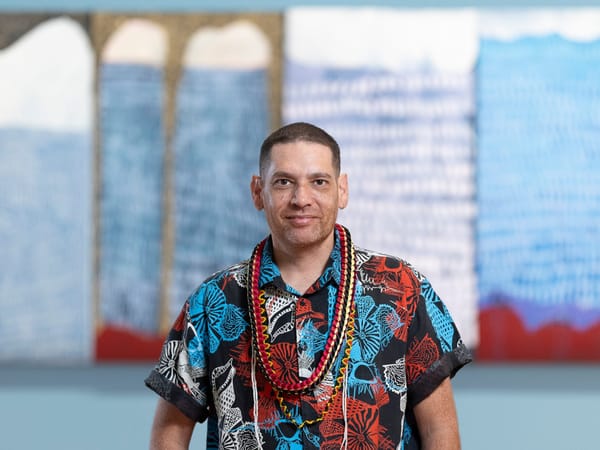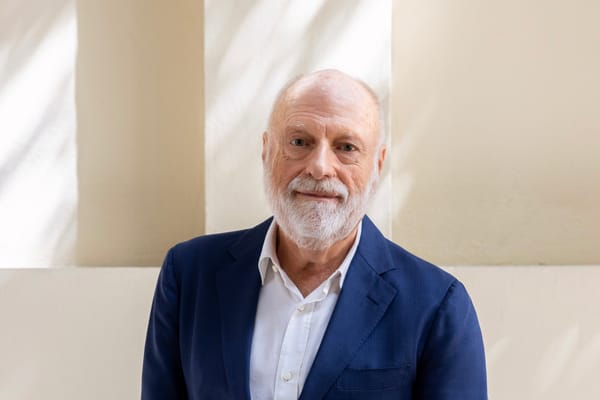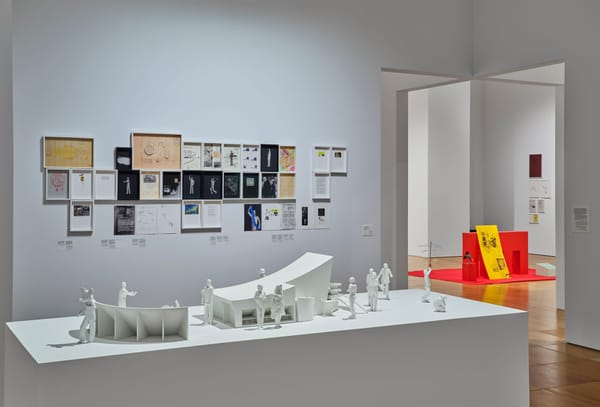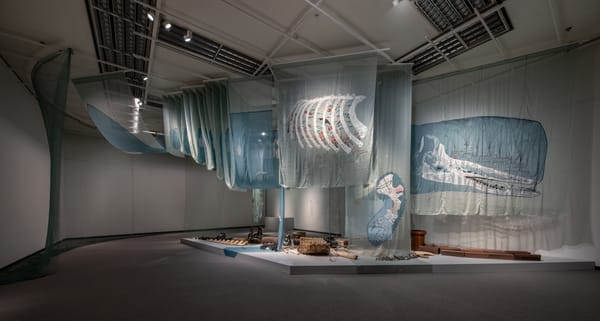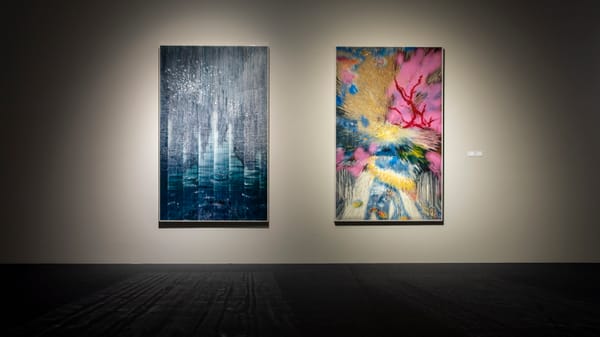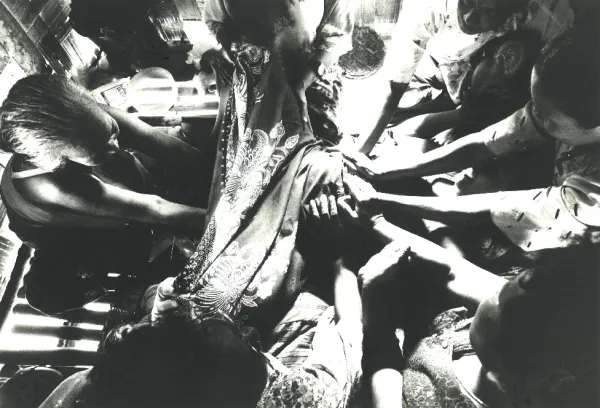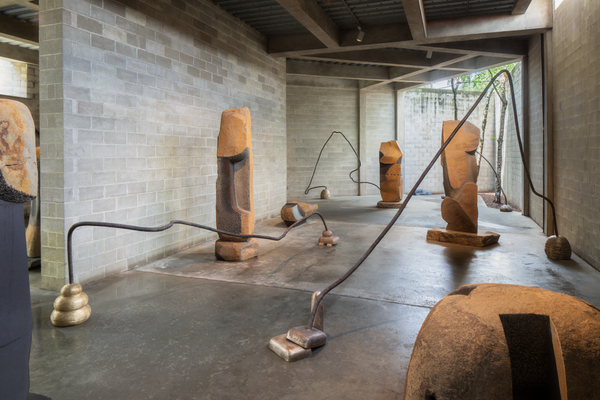Issue
Ruth Asawa: Retrospective

San Francisco Museum of Modern Art
Comprising more than 300 works, “Ruth Asawa: Retrospective,” which began its two-year tour at the San Francisco Museum of Modern Art (SFMOMA) in April, explored six decades of the artist’s groundbreaking practice. It also told—through onsite didactics and a multi-author catalog—the quietly compelling story of the artist’s life.
Most disconcerting to readers today are Asawa’s World War II experiences. Following Japan’s surprise attack on Pearl Harbor in December 1941, President Franklin D. Roosevelt signed executive orders prompting the internment of about 120,000 US residents of Japanese descent. In 1942, FBI agents picked up Asawa’s father, an immigrant Southern California vegetable farmer, and shipped him to New Mexico. Asawa, American-born and 16 at the time, was sent along with her mother and five siblings to the Santa Anita racetrack in Arcadia, California, which housed some 18,000 Japanese Americans in converted stables and hastily constructed barracks. Soon they were moved to the Rohwer Relocation Center in Arkansas, where 8,000 people lived surrounded by watchtowers and barbed wire fences. Asawa would not see her father again until after the war.
During her detainment, Asawa was instructed by volunteer teachers and tutored by two interned artists who had worked at Walt Disney Studios. Upon graduating, she received a scholarship to the Milwaukee State Teachers College in Wisconsin, where she trained to become an art teacher. However, two young artists there, Elaine and Elizabeth Schmitt, urged her to apply to Black Mountain College in North Carolina, where German American artist and former Bauhaus professor Josef Albers headed its visual arts program.
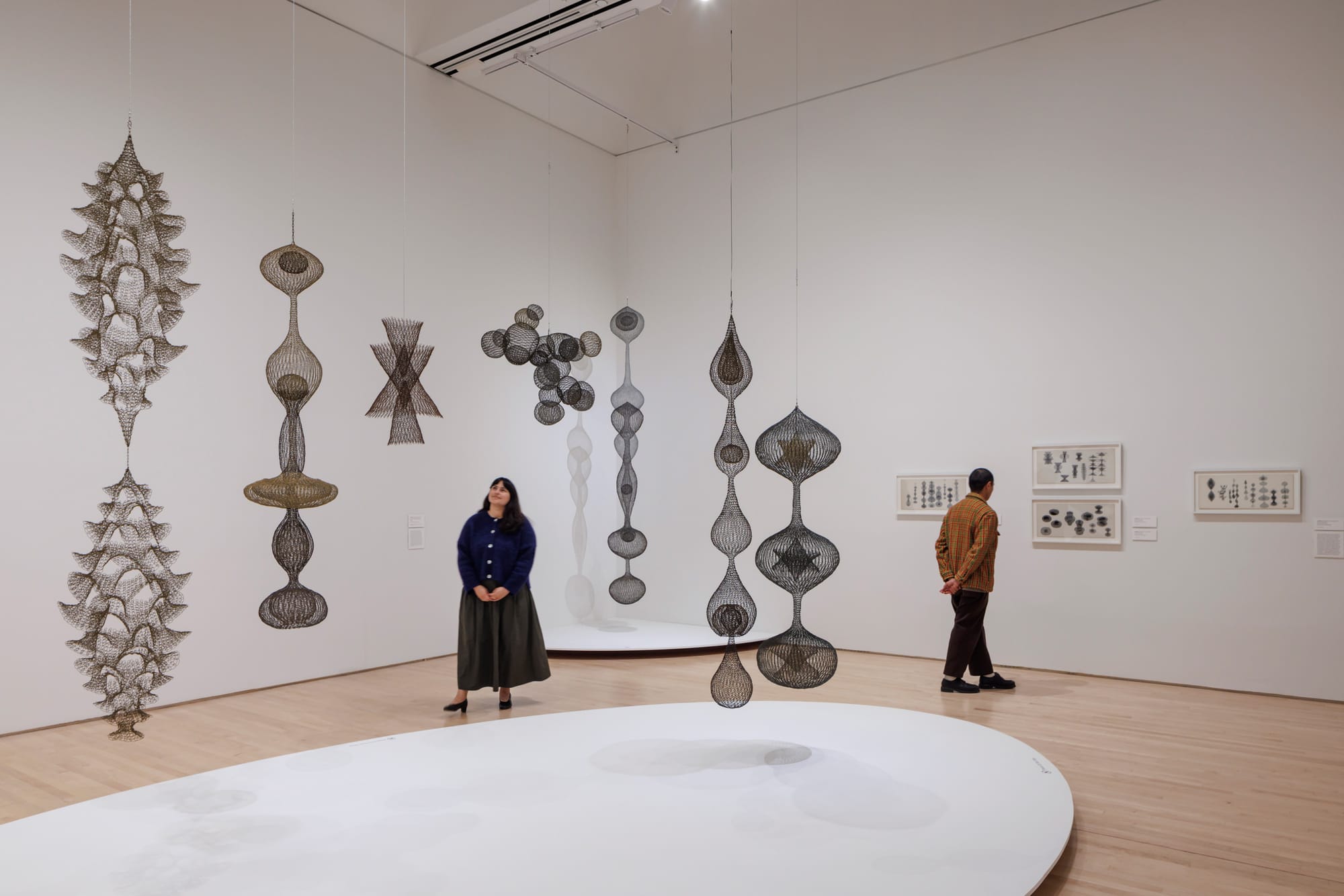
Asawa spent three years at Black Mountain, 1946–49, interacting with some of the preeminent figures of 20th-century American art—John Cage, Merce Cunningham, Willem and Elaine de Kooning, Robert Rauschenberg, and others. She studied with Buckminster Fuller, visionary architect and inventor of the geodesic dome.
In the summer of 1947, Asawa went to Mexico to volunteer with the Quaker American Friends Service Committee. In Mexico City she joined Josef and Anni Albers (the latter known for her abstract prints and fabric designs), and visited Frida Kahlo and Diego Rivera. While in Mexico, Asawa encountered some small, handwoven wire baskets used for carrying eggs. She was eager to learn the craft, a technique of weaving without the use of hooks or knitting needles.
Back at Black Mountain, she began to experiment with wire—different gauges of flexible copper, brass, iron, and galvanized steel—building suspended openwork sculptures that reveal continuous forms within forms: biomorphic, seemingly weightless, casting shadows like intricate crocheted lanterns.
In 1949 Asawa married architecture student Albert Lanier (Fuller designed her wedding ring) and moved to San Francisco so that Lanier could establish his architectural practice. Between 1950 and 1959, the couple had six children, and they remained dedicated partners until Lanier’s death in 2008.
Despite the demands and satisfactions of domestic life, Asawa never lost her artistic vision, or her ability to conjure a sense of volume without mass. Consider her Untitled S.250, Hanging Seven-Lobed Continuous Interlocking Form with Spheres in the First, Fifth, and Sixth Lobes (ca. 1955). Over three meters tall, blending layers of iron and galvanized steel wire, it encloses three delicate spheres. Grace McCann Morley, founding director of SFMOMA, selected this work for the group show “Pacific Coast Art,” which represented the US at the 1955 São Paulo Biennial.
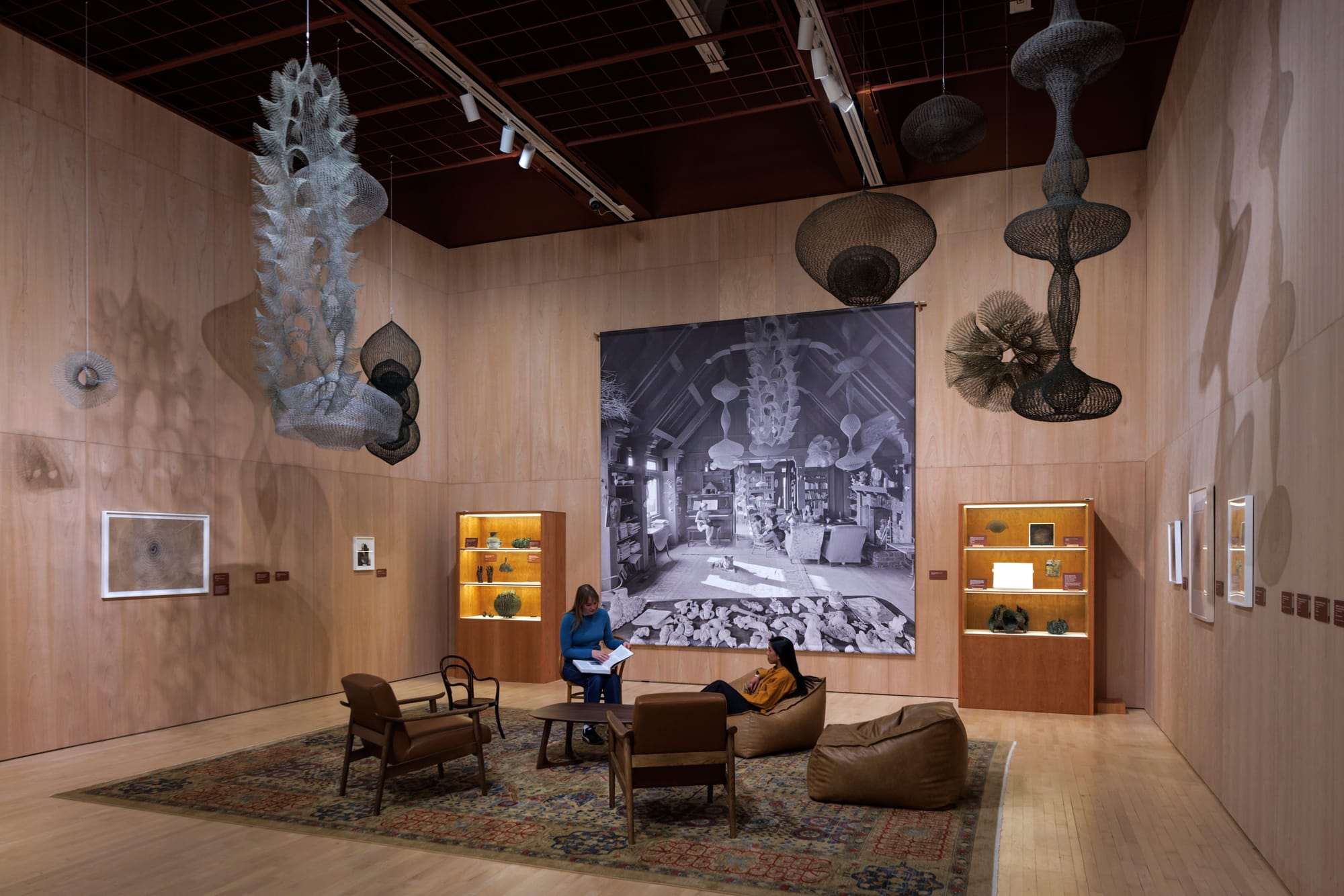
In the mid-1950s Asawa had three solo exhibitions with Peridot Gallery, New York, which also showed early work by Philip Guston and Louise Bourgeois. Chosen for various national and international exhibitions, Asawa’s pieces often appeared in magazines such as Time, Vogue, and Art News. Yet over time, she became increasingly disenchanted with the commercial art world and marketplace.
Fortunately, she had an excellent relationship with institutions. SFMOMA first included her work in a group show in 1949, followed by numerous group exhibitions thereafter. Her first museum solo was mounted at the M.H. de Young Memorial Museum in San Francisco in 1960. SFMOMA presented the midcareer survey “Ruth Asawa: A Retrospective View” in 1973. “The Sculpture of Ruth Asawa: Contours in the Air”—the last museum survey the artist would have in her lifetime—appeared in 2006 at the de Young Legion of Honor Fine Arts Museum of San Francisco.
Asawa’s notable public commissions include the Japanese American Internment Memorial in San José and fountains in Ghirardelli Square, Union Square, and the Embarcadero in San Francisco. In 1982 she succeeded in founding a public arts high school in San Francisco. The city renamed it the Ruth Asawa San Francisco School of the Arts in 2010.
The overall design of SFMOMA’s “Ruth Asawa: Retrospective” was superb, especially its chronological pacing. The wall labels featured miniature graphic renderings to help visitors identify each sculpture by its contours. In addition to a dazzling array of Asawa’s signature hanging sculptures, some displayed as single works and many more in groupings or clusters, the exhibition encompassed watercolors, monoprints, drawings, and other works on paper from the late 1940s and early ’50s, reflecting Albers’s ideas on color, design, composition, and transparency. Likewise, Fuller’s “geometry of thinking” clearly affected not only Asawa’s sculptural designs but also her approach to everyday materials. This is particularly evident in works like the stamped-ink-on-paper Untitled, Potato Print—Branches, Purple/Orange and Untitled, Apple Print—Blue/Pink (both ca. 1951–52).
Among the show’s many highlights was a recreation of the living room of Asawa and Lanier’s home in central San Francisco. In the 1960s, the couple bought and renovated the Arts and Craft-style house in what Asawa described as the quiet, working-class neighborhood of Noe Valley. Its vaulted 19-foot ceiling could accommodate numerous sculptures dangling from exposed beams, while works by Asawa’s mentors and friends occupied the wood-paneled walls. In this roomy interior, Asawa went about her art-making as a normal part of everyday family life.
The home was surrounded by flower and vegetable gardens, tended primarily by Lanier, from which Asawa took her inspiration for the astonishing number of drawings included in this exhibition. Her later knotted-wire sculptures—most of them wall-mounted, mandala-like works—signal a direct engagement with the natural world. But these works, overly literal in their reference to twigs and branches, seem slightly too New Age in spirit. They are neither as mystifying nor as innovative as her earlier looped and multi-lobed sculptures. In Asawa’s drawings, however, one senses a keen intelligence at work, seeking connection to nature’s forms.
Throughout her career, Asawa had to contend with a sexist tendency to classify her work as craft or design. Even the revered New York Times art critic Dore Ashton wrote of Asawa’s sculptures in 1956: “They are beautiful if primarily only decorative objects in space.”
But the times, and critical thinking, have changed. In 2024, more than a decade after her death in 2013 at age 87, Asawa was awarded the National Medal of Arts, the highest cultural award in the US. Moreover, this newest retrospective—co-curated by Janet Bishop, chief curator of SFMOMA, and Cara Manes, associate curator at the Museum of Modern Art in New York—will certainly advance Asawa’s stature in the historical canon.
Arthur Solway is the author of two collections of poetry, Friday Night, Shanghai (Finishing Line Press, 2023) and Siddhartha On Fire (Swan Scythe Press, 2023). He is ArtAsiaPacific’s San Francisco desk editor.
